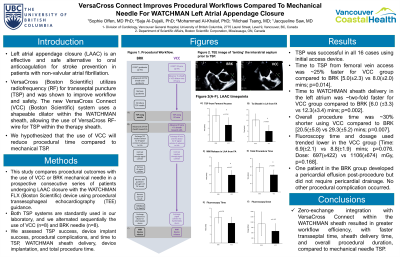Cardiac: Structural Heart
VersaCross Connect improves procedural workflow compared to mechanical needle for WATCHMAN Left Atrial Appendage Closure

Purpose: Left atrial appendage closure (LAAC) is an effective and safe alternative to oral anticoagulation for stroke prevention in patients with non-valvular atrial fibrillation. VersaCross (Boston Scientific) utilizes radiofrequency (RF) for transseptal puncture (TSP), and was shown to improve workflow and safety. The new VersaCross Connect (VCC) (Boston Scientific) system uses a shapeable dilator within the WATCHMAN sheath, allowing the use of VersaCross RF-wire for TSP within the WATCHMAN sheath. We hypothesized that the use of VCC will reduce procedural time compared to mechanical TSP.
Material and Methods: We compared the procedural outcomes with the use of VCC or BRK mechanical needle in a prospective consecutive series of patients undergoing LAAC closure with the WATCHMAN FLX (Boston Scientific) device using procedural transesophageal echocardiography (TEE) guidance. Both TSP systems are standardly used in our laboratory, and we alternated sequentially the use of VCC (n=8) and BRK needle (n=8). We assessed TSP success, device implant success, procedural complications, and time to TSP, WATCHMAN sheath delivery, device implantation, and total procedure time.
Results: TSP was successful in all 16 cases using initial access device. Time to TSP from femoral vein access was ~25% faster for VCC group compared to BRK [5.0(±2.3) vs 8.0(±2.0) mins; p=0.014]. Time to WATCHMAN sheath delivery in the left atrium was ~two-fold faster for VCC group compared to BRK [6.0 (±3.3) vs 12.3(±3.4) mins; p=0.002]. Time to WATCHMAN device implantation was faster in the VCC group [19.8(±5.8) vs 28.3(±5.2) mins; p=0.008]. Overall procedure time was ~30% shorter using VCC compared to BRK [20.5(±5.8) vs 29.3(±5.2) mins; p=0.007]. Fluoroscopy time and dosage used trended lower in the VCC group [Time: 6.9(±2.1) vs 8.8(±1.9) mins; p=0.076. Dose: 697(±422) vs 1106(±674) mGy, p=0.168]. One patient in the BRK group developed pericardial effusion post-procedure, but did not require pericardial drainage. No other procedural complication occurred.
Conclusions: Zero-exchange integration with VersaCross Connect within the WATCHMAN sheath resulted in greater workflow efficiency, with faster transseptal time, sheath delivery time, and overall procedural duration, compared to mechanical needle TSP.
Material and Methods: We compared the procedural outcomes with the use of VCC or BRK mechanical needle in a prospective consecutive series of patients undergoing LAAC closure with the WATCHMAN FLX (Boston Scientific) device using procedural transesophageal echocardiography (TEE) guidance. Both TSP systems are standardly used in our laboratory, and we alternated sequentially the use of VCC (n=8) and BRK needle (n=8). We assessed TSP success, device implant success, procedural complications, and time to TSP, WATCHMAN sheath delivery, device implantation, and total procedure time.
Results: TSP was successful in all 16 cases using initial access device. Time to TSP from femoral vein access was ~25% faster for VCC group compared to BRK [5.0(±2.3) vs 8.0(±2.0) mins; p=0.014]. Time to WATCHMAN sheath delivery in the left atrium was ~two-fold faster for VCC group compared to BRK [6.0 (±3.3) vs 12.3(±3.4) mins; p=0.002]. Time to WATCHMAN device implantation was faster in the VCC group [19.8(±5.8) vs 28.3(±5.2) mins; p=0.008]. Overall procedure time was ~30% shorter using VCC compared to BRK [20.5(±5.8) vs 29.3(±5.2) mins; p=0.007]. Fluoroscopy time and dosage used trended lower in the VCC group [Time: 6.9(±2.1) vs 8.8(±1.9) mins; p=0.076. Dose: 697(±422) vs 1106(±674) mGy, p=0.168]. One patient in the BRK group developed pericardial effusion post-procedure, but did not require pericardial drainage. No other procedural complication occurred.
Conclusions: Zero-exchange integration with VersaCross Connect within the WATCHMAN sheath resulted in greater workflow efficiency, with faster transseptal time, sheath delivery time, and overall procedural duration, compared to mechanical needle TSP.
